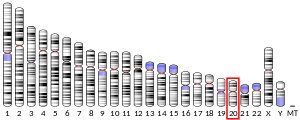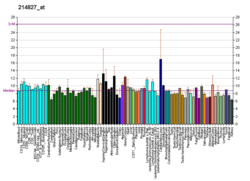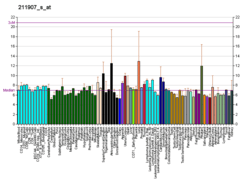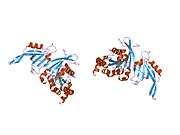PARD6B
Partitioning defective 6 homolog beta is a protein that in humans is encoded by the PARD6B gene.[5][6]
Function
This gene is a member of the PAR6 family and encodes a protein with a PSD95/Discs-large/ZO1 (PDZ) domain, an OPR domain and a semi-Cdc42/Rac interactive binding (CRIB) domain. This cytoplasmic protein is involved in asymmetrical cell division and cell polarization processes as a member of a multi-protein complex.[6]
Interactions
PARD6B has been shown to interact with:
gollark: Mine always uses the quotes.
gollark: Oh, right, R. Danny's also has some accursed NLP glued on.
gollark: The ABR one is a little more general and can do SI prefixes.
gollark: They have roughly the same parser.
gollark: Also memetics.
References
- GRCh38: Ensembl release 89: ENSG00000124171 - Ensembl, May 2017
- GRCm38: Ensembl release 89: ENSMUSG00000044641 - Ensembl, May 2017
- "Human PubMed Reference:". National Center for Biotechnology Information, U.S. National Library of Medicine.
- "Mouse PubMed Reference:". National Center for Biotechnology Information, U.S. National Library of Medicine.
- Noda Y, Takeya R, Ohno S, Naito S, Ito T, Sumimoto H (March 2001). "Human homologues of the Caenorhabditis elegans cell polarity protein PAR6 as an adaptor that links the small GTPases Rac and Cdc42 to atypical protein kinase C". Genes Cells. 6 (2): 107–19. doi:10.1046/j.1365-2443.2001.00404.x. PMID 11260256.
- "Entrez Gene: PARD6B par-6 partitioning defective 6 homolog beta (C. elegans)".
- Neudauer CL, Joberty G, Macara IG (January 2001). "PIST: a novel PDZ/coiled-coil domain binding partner for the rho-family GTPase TC10". Biochem. Biophys. Res. Commun. 280 (2): 541–7. doi:10.1006/bbrc.2000.4160. PMID 11162552.
- Joberty G, Petersen C, Gao L, Macara IG (August 2000). "The cell-polarity protein Par6 links Par3 and atypical protein kinase C to Cdc42". Nat. Cell Biol. 2 (8): 531–9. doi:10.1038/35019573. PMID 10934474.
Further reading
- Joberty G, Petersen C, Gao L, Macara IG (2000). "The cell-polarity protein Par6 links Par3 and atypical protein kinase C to Cdc42". Nat. Cell Biol. 2 (8): 531–9. doi:10.1038/35019573. PMID 10934474.
- Gao L, Macara IG, Joberty G (2003). "Multiple splice variants of Par3 and of a novel related gene, Par3L, produce proteins with different binding properties". Gene. 294 (1–2): 99–107. doi:10.1016/S0378-1119(02)00681-9. PMID 12234671.
- Kohjima M, Noda Y, Takeya R, Saito N, Takeuchi K, Sumimoto H (2003). "PAR3beta, a novel homologue of the cell polarity protein PAR3, localizes to tight junctions". Biochem. Biophys. Res. Commun. 299 (4): 641–6. doi:10.1016/S0006-291X(02)02698-0. PMID 12459187.
- Hurd TW, Gao L, Roh MH, Macara IG, Margolis B (2003). "Direct interaction of two polarity complexes implicated in epithelial tight junction assembly". Nat. Cell Biol. 5 (2): 137–42. doi:10.1038/ncb923. PMID 12545177.
- Yamanaka T, Horikoshi Y, Sugiyama Y, Ishiyama C, Suzuki A, Hirose T, Iwamatsu A, Shinohara A, Ohno S (2004). "Mammalian Lgl forms a protein complex with PAR-6 and aPKC independently of PAR-3 to regulate epithelial cell polarity". Curr. Biol. 13 (9): 734–43. doi:10.1016/S0960-9822(03)00244-6. PMID 12725730.
- Brajenovic M, Joberty G, Küster B, Bouwmeester T, Drewes G (2004). "Comprehensive proteomic analysis of human Par protein complexes reveals an interconnected protein network". J. Biol. Chem. 279 (13): 12804–11. doi:10.1074/jbc.M312171200. PMID 14676191.
- Labhart P, Karmakar S, Salicru EM, Egan BS, Alexiadis V, O'Malley BW, Smith CL (2005). "Identification of target genes in breast cancer cells directly regulated by the SRC-3/AIB1 coactivator". Proc. Natl. Acad. Sci. U.S.A. 102 (5): 1339–44. doi:10.1073/pnas.0409578102. PMC 547886. PMID 15677324.
This article is issued from Wikipedia. The text is licensed under Creative Commons - Attribution - Sharealike. Additional terms may apply for the media files.







